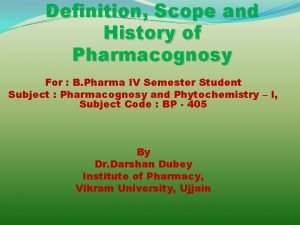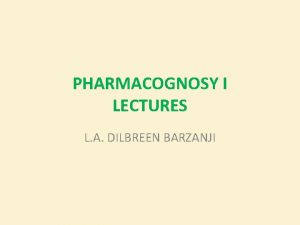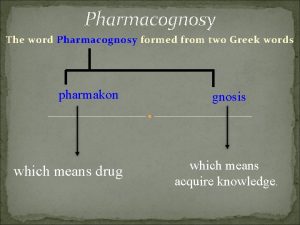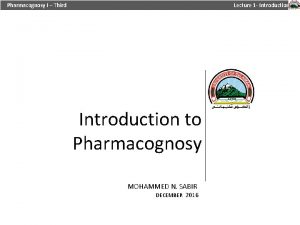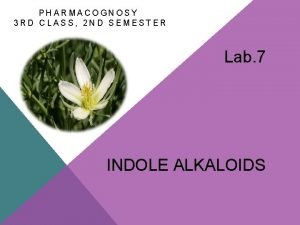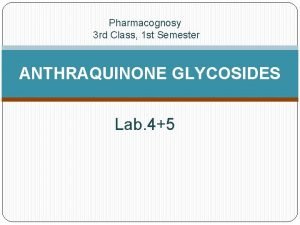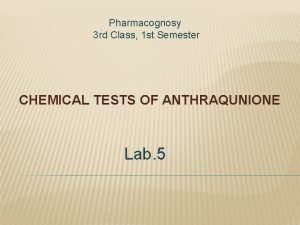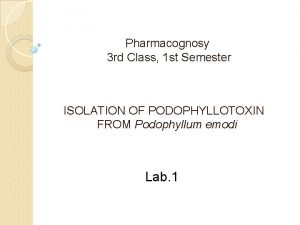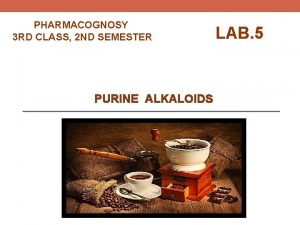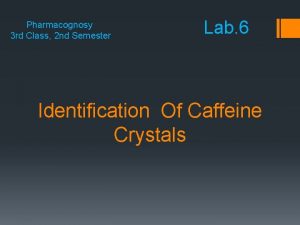Pharmacognosy 3 rd Class 1 st Semester THE











- Slides: 11

Pharmacognosy 3 rd Class, 1 st Semester THE IDENTIFICATION OF THE CARDIO ACTIVE GLYCOSIDES Lab. 4

GENERAL CHEMICAL TESTS 1) BALJETS TEST Aim The identification of the cardio active glycosides in general. Equipment and reagents v Test tube v Picric acid v Sodium hydroxide solution Procedure 1) Take one ml of fraction A. 2) Add two drops of picric acid. 3) Make it alkaline with sodium hydroxide solution. Results Turbid, yellow to orange in color. Discussion v. The use of picric acid is to hydrolyze the glycoside to glycone and aglycone parts. v The use of sodium hydroxide is to neutralize the acidity in the solution. v. The color is product due to the aglycone portion (genin).

2) KELLER-KILLIANS TEST Aim The identification of the cardio active glycosides in general. Equipment and reagent v. Test tube v. Glacial acetic acid v 0. 1%of ferric chloride solution v. Concentrated H 2 SO 4 Procedure 1) Take two ml of fraction A and add 3 ml of glacial acetic acid. 2) Add two drops of 0. 1%of ferric chloride solution. 3) Take 1 ml of concentrated H 2 SO 4 and add it to the above mixture in drops so as to make two layers. Results Two layers are formed: 1) The upper one has light bright green color. 2) The lower layer has transparent clear color (H 2 SO 4 Layer) the junction appears as a reddish-brown ring

Discussion v. The color of the acetic acid layer is due to the genin part of the glycoside. v. The use of glacial acetic acid is to hydrolyze the glycoside into glycone and aglycone parts. v The addition of 0. 1 % ferric chloride is an oxidizing agent needed in the reaction. v. The H 2 SO 4 has a high density therefore will be in the lower layer causing charring of the sugar and hence giving the reddish-brown color.

OTHER CHEMICAL TEST FOR THE IDENTIFICATION OF THE STEROL GLYCOSIDES v Sterol glycosides (SGs) occur naturally in vegetable oils and fats. 1) RAYMMONDS REACTION Aim To identify the sterol nucleus Equipment and reagents v. Test tube v 10%sodium hydroxide solution v 1% m-dinitrobenzene Procedure 1) To an alcoholic solution of glycoside add 1 -2 drops of 10%sodium hydroxide. 2) Add few drops of an alcoholic solution of 1% m- dinitrobenzene. 3) Note the color. Results Pink color appears

2)KEDDS REACTION Aim To identify the sterol nucleus Equipment and reagents v. Test tube v 1%3, 5 -dinitrobenzene acid v 0. 5 N aqueous methanolic KOH (50%) Procedure 1) To a solution of glycoside add a solution of 1%3, 5 -dinitrobenzene acid in 0. 5 N aqueous methanolic KOH (50%). 2) Report the color. Results Violet color

3)LIEBERMANS STEROL REACTION Aim To identify the sterol nucleus Equipment and reagents v. Test tube v. Porcelain dish v. Anhydrous acetic acid v. Concentrated H 2 SO 4 Procedure 1) Take 5 ml of the alcoholic extract in a test tube. 2) Add 5 ml of the anhydrous acetic acid and shake well. 3) Take 4 drops of the above mixture and place in a porcelain dish. 4) Add 0 ne drop of concentrated H 2 SO 4. Results Achange of color from rose, through red , violet, and blue to green. The color is slightly different from compound to compound. Discussion This reaction is due to the steroidal part of the molecule and it is characteristic of the aglycone of the scillarenin type (unsaturated steroidal part)

LEGALS REACTION The glycoside or the purified extract of the crude drug is dissolved in pyridine. When sodium hydroxide and sodium nitroprusside are added alternatively, a transient blood red color develops. This is a test for the unsaturated lactone ring of the genin. Cardenolide in pyridine + Na nitroprusside + Na. OH Deep red colour

THE IDENTIFICATION OF CARDIO ACTIVE GLYCOSIDE BY CHROMATOGRAPHY v. By the use of thin layer chromatography (T. L. C) v. The stationary phase=silica gel G v. The mobile phase Chloroform: Ethanol: Water (7: 3: 1) Or Ethyl acetate: Methanol: Water (75: 10: 5) v The standard compound =Oleanderin, Digoxin v. The spray reagent=Lieberman's reagent. v. Other mobile phase as v Butanone: Xylene: Formamide (50: 5: 4) v Chloroform: Tetrahydrofuran: Formamide(50: 6)

Procedure 1) Prepare 100 ml of the mobile phase; place it in the glass tank. 2) Cover the tank with glass lid and allow standing for 45 minutes before use. 3) Apply the sample spots (fraction A and fraction B) and the standard spot, on the silica gel plates, on the base line. 4) Put the silica gel plate in the glass tank and allow the mobile phase to raise to 90% of the plate. 5) Remove the plate from the tank. 6) Allow drying and then detecting the spots by use of the spray reagent and heat the plate at 105 -110 c for 5 -10 minutes in the oven. 7) Note the spots, and calculate the RF value for each spot. v. Note: - v. The RF value= distance moved by the sample /distance moved by the solvent. v. The RF value should be less than 1 because if the RF value=1 this means that there is no separation, and the sample moved with the solvent.

THANK YOU
